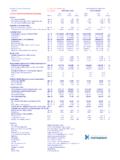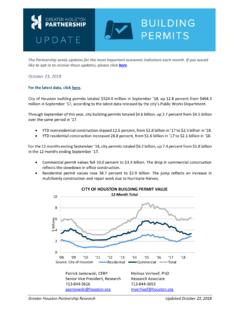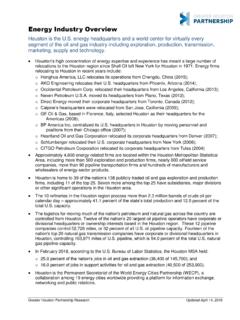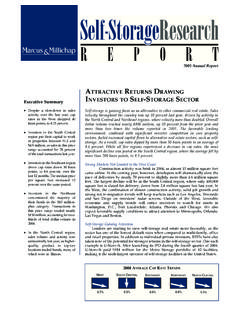Transcription of Commercial Leasing A publication of the Greater …
1 April 2018 economy at a glance 2018, Greater Houston Partnership 1 METRO POPULATION UPDATE Houston s population grew in 17, but at the slowest pace in 20 years. Growth would have been weaker still if not for the influx of residents from overseas and fertility rates that are bucking national trends. Population gains will be tepid this year and next. Houston won t draw residents from other metros until the local economy improves and robust job growth resumes. Even when the economy fully recovers, negative perceptions will linger. Houston needs a sustained period of economic growth if job-seekers are to load their possessions into U-Hauls and set out for the Bayou City. Until then, population growth will remain subdued. From July 1, 2016 to July 1, 2017, the period covered by the Census Bureau s latest estimates, metro Houston added 94,417 residents, a percent gain.
2 That s the smallest increase since 99 and the weakest percent change since 88. Though Houston ranked second only to Dallas-Fort Worth in absolute gains, a review of the data suggests Houston shouldn t brag. Domestic Migration Houston saw negative domestic migration in 17. In layman s terms, more people left Houston than moved here from other parts of the That s only the fourth time since 90 that out-migration exceeded in-migration. Each time, the exodus overlapped a weak economy and regional job losses. Last year s out-migration shouldn t be a surprise. Houston lost jobs in 15 and 16, and growth didn t resume until late 17. The unemployed, unable to find work here, left for metros with better job prospects. Nor can out-migration be blamed on residents displaced by Hurricane Harvey. The Census Bureau s estimates cover the 12 months ending July 1.
3 Harvey didn t hit Houston until late August. Any impact from Harvey will appear in the estimates for 18. Any loss of permanent residents may be offset by the influx of workers to repair storm damage. COMPONENTS OF METRO POPULATION GROWTH* 16 17 Avg. 10 16 Natural Increase Births 102,941 95,926 Deaths -41,404 -36,249 Net Natural 61,537 59,677 Migration International 43,094 30,978 Domestic -10,372 45,318 Net Migration 32,722 76,296 Overall Change 94,417 136,315 Metro Houston includes Austin, Brazoria, Chambers, Fort Bend, Galveston, Harris, Liberty, Montgomery and Waller counties. * For the 12 months ending July 1 of each year. Source: Census Bureau and Partnership calculations Note: Totals may not sum due to rounding and other factors. International Migration On a positive note, international net migration set a record in 17. This figure includes ex-pat workers called home from overseas assignments, military personnel redeployed stateside, foreigners arriving on work visas, international students enrolling in local universities, relief agencies placing refugees in Houston, and immigrants (legal and undocumented) settling here.
4 Table of Contents Metro Population Update .. 1 How Houston 2 Metro Houston Details .. 4 Employment Update .. 5 Second Place Finish .. 5 Fourth Annual Houston s Global economy .. 5 Snapshot Key Economic Indicators .. 6 Economic Indicators Summary Table .. 7 A publication of the Greater Houston Partnership Volume 27 Number 4 April 2018 A publication of the Greater Houston Partnership Volume 26 Number 12 December 2017 April 2018 economy at a glance 2018, Greater Houston Partnership 2 If not for the influx of residents from abroad, Houston would have logged negative net migration. In other words, if not for the immigrants, expats, and foreign workers, more people would have left Houston than moved here last year. Instead, Houston gained about 33,000 residents via net migration in 17 less than half the long-term average. Houston placed 11th among metros in net migration, behind Miami but ahead of San Antonio a decent finish, but nothing to brag about.
5 Dallas-Fort Worth ranked first. Why Care? Positive net migration is important because it grows the labor force, brings new skills into the region, expands the market for consumer goods and services, and adds to the region s diversity. Perhaps the greatest negative to positive net migration is that it adds to the region s traffic congestion. Last year s out-migration likely siphoned off some skilled workers. We won t know the extent until September, when the Census Bureau releases results from the 2017 American Community Survey. The population base expanded, so the consumer base expanded, but not enough to offset the 80,000 highly compensated jobs cut during the energy downturn. And with the influx of so many residents from abroad, the region is undoubtedly more diverse. Natural Increase Houston set a record for births and deaths in 17.
6 The net natural increase ( , resident births minus resident deaths) also helped offset negative domestic migration. The region s fertility rate, measured as the number of births per women of child-bearing age, remains somewhat higher than the rate for the rest of the nation and significantly higher than that of the nation s largest metro areas, helping to feed local population growth. The data also suggest that birth rates and domestic migration respond in different ways to swings in the local economy : In 09, when Houston lost 110,000 jobs, the region recorded 96,400 births, a near-record figure at the time. 1 The forecast assumed that oil would hover in the low $50s most of the year. If oil stays above $60, job growth would likely be higher. In 14, when Houston created nearly 120,000 jobs, the region recorded 94,800 births, a slight drop from recent trends.
7 Though demographers project the rate of natural increase to slow the population continues to age, couples are having fewer children that has yet to happen. Houston has set a record for resident births in 15, 16 and 17. The overarching trend should continue, with the region adding 60,000 or more new residents each year through the net natural increase. Growth Outlook Domestic migrants move here for a variety of reasons to be closer to family, to escape harsh winters, to start a business, to live in a more affordable city but a robust job market is the biggest draw. The Partnership s forecast calls for the region to create 45,500 jobs in 18 still short of its long-term average of 60,000 jobs per Until the job market improves, net domestic migration will remain weak. Immigrants prefer metros that already have large popula-tions of their fellow countrymen.
8 Houston already has a large foreign-born population one in four Houstonians was born overseas. Houston also has a reputation of welcoming newcomers, whether they re from California or Kathmandu. Houston will continue to draw residents from abroad, but the anti-immigrant rhetoric emanating from Washington may somewhat temper that growth. If Houston returns to its long-term average, the region would add approximately 125,000 residents per year and 625,000 over the next five years. Ray Perryman, an economist who s tracked Houston s economy since the early 80s, forecasts the region to add 593,000 residents by the end of 22. HOW HOUSTON COMPARES Houston, with a population of million, remains the nation s fifth most populous metro area, a distinction FERTILITY RATES IN 16 Births Per 1,000 Women, Ages 15 50 Years Metro Houston 59 Average, 20 Most Populous Metros 50 Average 52 Source: Census Bureau and Partnership calculations April 2018 economy at a glance 2018, Greater Houston Partnership 3 we ve held since 11 after leapfrogging metro Philadelphia.
9 Houston is unlikely to overtake Dallas-Fort Worth to become the fourth most populous metro. Our neighbor to the north is growing much faster than we are. But neither is Houston at risk of slipping in the rankings. We re still growing faster than Washington or Miami, the metros directly behind us. In one regard, Houston is very much like its peers. Twelve of the top 20 metros Baltimore, Boston, Chicago, Detroit, Houston, Los Angeles, Miami, New York, Philadelphia, San Diego, San Francisco and Washington saw an outflow of residents. With two exceptions, those metros had one thing in common they are expensive places to live. All except Houston and Detroit have living costs 15 percent or more above the average. And all except for Houston and Detroit have housing costs 30 percent or more above the average. International migration was strong enough to offset the domestic losses in Boston, Houston, Miami, Philadelphia, San Diego, San Francisco and Washington.
10 For the remaining five metros that posted losses in domestic migration, an influx of immigrants couldn t stem the tide. If not for the natural increase, those metros would have lost population. Only Chicago lacked enough international migration or births to offset domestic out-migration. The Windy City metro has lost population the past three years. However, it still has million more residents than metro Houston. COMPONENTS OF POPULATION CHANGE, 20 MOST POPULOUS METROS, 7/1/16 TO 7/1/17 (Ranked by Total Change in 17) Metro Area Total Population Total Change Vital Events Migration Natural Increase Births Deaths Net International Domestic Dallas-Fort Worth 7,399,662 146,238 56,597 102,423 45,826 89,627 30,798 58,829 Houston 6,892,427 94,417 61,537 102,941 41,404 32,722 43,094 -10,372 Atlanta 5,884,736 89,013 35,270 73,810 38,540 53,739 20,451 33,288 Phoenix 4,737,270 88,772 25,216 59,592 34,376 63,359 12,070 51,289 Washington 6,216,589 65,908 42,616 80,082 37,466 23,217 44,760 -21,543 Seattle 3,867,046 64,386 21,811 47,792 25,981 42,466 21,394 21,072 Riverside 4,580,670 57,017 29,083 60,916 31,833 28,037 6,787 21,250 Tampa 3,091,399 54,874 415 33,111 32,696 54,321 13,725 40,596 Miami 6,158,824 51,391 16,670 69,419 52,749 34,647 81,824 -47,177 New York 20,320,876 45,697 93,496 245,608 152,112 -48,021 160,842 -208,863 Minneapolis 3,600,618 43,342 22,283 45,810 23,527 21,202 13,107 8.













